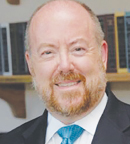
Charles F. von Gunten, MD, PhD

Leslie J. Blackhall, MD
As the number of opioid-related deaths continues to rise in the United States, stakeholders are struggling to make sense of the crisis. At the 2018 Palliative and Supportive Care in Oncology Symposium, two experts in the field, Charles F. von Gunten, MD, PhD, and Leslie J. Blackhall, MD, attempted to rise above the hyperbole that has characterized the media’s coverage and proffer evidence-based solutions to protect patients in need.1,2
Dr. von Gunten, Vice President of Medical Affairs Hospice & Palliative Medicine at OhioHealth Kobacker House, focused on the importance of safeguarding opioid access for patients with moderate-to-severe cancer pain. Dr. Blackhall, Section Head of Palliative Care at the University of Virginia School of Medicine, discussed the consequences and outcomes of access treating patients with pain and a substance use disorder or treating patients who have a close family member with a substance use disorder.
Protecting Opioid Access: Caring for Patients in Need
“Emotion, not data, is what’s driving the current debate, and it’s hurting patients,” said Dr. von Gunten. “The evidence base for opioids for moderate to severe cancer pain is firm. We must ensure that professionalism, and not fear, guides oncology practice.”
The evidence base for opioids for moderate to severe cancer pain is firm. We must ensure that professionalism, and not fear, guides oncology practice.— Charles F. von Gunten, MD, PhD
Tweet this quote
Although there is an increasing number of opioid overdose deaths, said Dr. von Gunten, according to data from the Centers for Disease Control and Prevention, these numbers are driven by illicit fentanyl, not prescription fentanyl. Moreover, the best evidence concerning opioid use disorder suggests it is first observed in individuals in their late teens or early 20s. “Although the prevalence among those older than age 18 is 0.37%, the prevalence decreases with increasing age,” commented Dr. von Gunten. “The main risk factor for cancer is age, and that is not a risk factor for opioid use disorder.”
Although the lack of data about the underlying causes of opioid use disorder may provide fuel for fearmongering, said Dr. von Gunten, the prevalence of opioid abuse remains low—there are approximately 2 million opioid addicts and 60,000 opioid-related deaths in the United States each year—and is even lower in those with cancer pain.
According to Dr. von Gunten, the principal issue is diversion, bolstered by poorly secured medication, whether the pills are in a medicine chest, a bedside table, or in the kitchen. “The solution is to keep opioids in a secure location,” said Dr. von Gunten, who added that the length of the prescription must also reflect the expected course. “If it’s a short course for a sprained ankle, that means 2 to 4 pills, not 30 to 60 pills; but if it’s for cancer pain, it should be enough for people to take throughout the month.”
The main risk factor for cancer is age, and that is not a risk factor for opioid use disorder.— Charles F. von Gunten, MD, PhD
Tweet this quote
Despite the overwhelming evidence that opioids are safe and effective for cancer-related pain, the current climate of fear has caused many providers to shirk the responsibility of managing pain, said Dr. von Gunten. Nevertheless, opioids remain the mainstay for cancer pain.
“Whether it’s stigmatization, labeling, or making assumptions before knowing a patient, there’s a whole other layer to treating patients with opioids,” Dr. von Gunten concluded. “This is why we must have the professional values to stick to what we know are the data vs the fearmongering, which can lead people to be afraid and then withdraw from doing the right thing because of the emotions.”
Opioid Access: Consequences and Outcomes
Opioids may be the mainstay of cancer pain management, but a cancer diagnosis does not make someone immune to a substance use disorder, said Dr. Blackhall. She emphasized that the key to treating cancer pain is proper evaluation, prescribing more safely, and patient monitoring.
Although the data about how many patients with cancer are misusing opiates are difficult to come by, said Dr. Blackhall, a few studies indicate that opioid abuse is not that uncommon. One study conducted by the Palliative Care Clinic at the University of Virginia found that 12% of referred patients had a history of or current prescription drug abuse. A separate study by MD Anderson Cancer Center found that 29% of patients were at high risk for opioid abuse using the Screener and Opioid Assessment for Patients with Pain (SOAPP) tool.3
“In the general population, there is a pretty high rate of substance use disorder, and it’s not just opiates,” Dr. Blackhall explained. Cancer patients and their family members are both at risk.”
It’s our job to use our judgment—not to be judgmental. If you’re not screening for [substance abuse], you’re missing the fact that some of your patients and their family members have this problem.— Leslie J. Blackhall, MD
Tweet this quote
To deal with this problem, Dr. Blackhall and colleagues at the University of Virginia have implemented a strategy of universal screening, universal monitoring, and universal education in how to use opioids safely. To begin, all patients seen undergo evaluation on their initial visit as if they were in a pain clinic, and the Opioid Risk Tool is employed because of its brevity.
Although the tool has not been validated in oncology, Dr. Blackhall and colleagues have found that people who scored at moderate to high risk in their practice were at much higher risk of having an abnormal urine drug screen.3 She also emphasized that the screening tool is not just about checking boxes. “The point of this tool is to start conversations,” said Dr. Blackhall, adding that patients are seldom offended by this dialogue.
For patients found to be at high risk for opioid use disorder, Dr. Blackhall recommends involving social workers or psychologists from the beginning for counseling on how to take these medications safely. High-risk patients should also be given a shorter supply of opioids (1 week vs 1 month) and have weekly or biweekly visits. With each visit, these patients should undergo urine drug screening and receive a prescription monitoring program check; then clinicians should reevaluate them. If everything checks out, the visits can be moved farther apart, she indicated.
“Part of our job should be getting people the help they need for an issue with substance abuse,” she concluded. “It’s our job to use our judgment—not to be judgmental—and to try to assess and treat people the right way. If you’re not screening for it, you’re missing the fact that some of your patients and their family members have this problem.” ■
DISCLOSURE: Drs. von Gunten and Blackhall reported no conflicts of interest.
REFERENCES
3. Barclay JS, Owens JE, Blackhall LJ: Screening for substance abuse risk in cancer patients using the Opioid Risk Tool and urine drug screen. Support Care Cancer 22:1883-1888, 2014.

